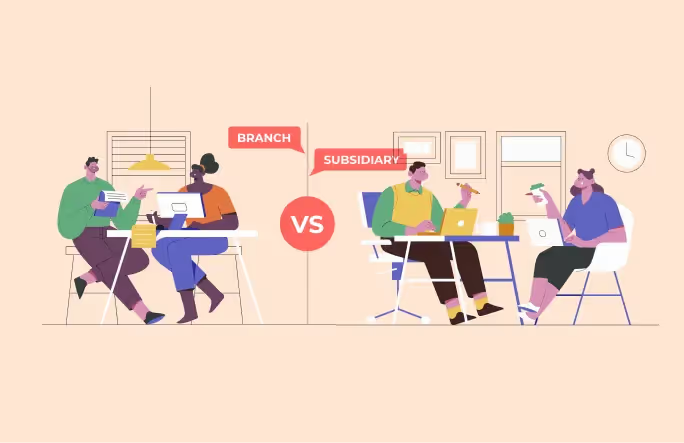One of the most critical decisions that a business has to make while going for a global expansion is whether to establish a branch or a subsidiary. Although these two terms are often used interchangeably, legally speaking, both are different and have distinct legal implications. This article dissects the pros and cons of each to guide companies in navigating the complexities of going global.
What is the difference between a branch and a subsidiary?
A branch is an operational unit of a company in a separate location from its headquarters. A branch functions as an extension of the parent company, carrying out various business operations within a specific geographic area. A branch is always connected to its main office and performs the same business operations as performed by the main office. By setting up a branch, a company can expand its presence into different regions without setting up fully independent entities.
For example, Bank of America is a large financial institution with multiple branch offices worldwide. All the branch offices are a part of the main office in North Carolina. Each branch office operates as an extension of the main office, thus reaching out to more customers.
A subsidiary is a legally independent business entity controlled, either partially or entirely, by the parent or holding company. The parent company typically owns a significant portion of the subsidiary’s shares. A subsidiary maintains its distinct legal identity, governance structure, and financial records. This organizational arrangement allows the parent company to enter new markets while limiting the risks associated with the subsidiary’s operations. Subsidiaries are considered when a company seeks diversified global expansion.
For example, The Walt Disney Company is a larger parent company with a Pixar Animation Studio subsidiary. As the requirement of a subsidiary, Disney has a majority stake in Pixar. Although Pixar operates as an independent entity, it's always under the umbrella of its parent company — Disney.
Which is better for global expansion & hiring: Branch or subsidiary
While there is no clear answer to this question, business owners need to consider carefully before going ahead with branch expansion or setting up subsidiaries. Some of the important factors to consider:
1- What’s your purpose?
While a branch office is set up to serve more customers with easy administration, a subsidiary has the sole purpose of expanding its business.
2- What business operation do you want to drive?
While a branch performs the same function as the main office, a subsidiary may operate independently and not conduct the same operations as the parent company.
3- Legal and regulatory environment
The legal and regulatory environment of the host country should be considered, as each country has its laws and regulations for subsidiaries and branch offices.
4- Tax requirements
Subsidiaries and branch offices have separate tax implications, so you need to consult tax experts to understand the better option for you.
5- Liability concerns
You also need to assess the liability concerns. For example, a subsidiary can be a better choice if the parent company wants to limit the liability.
What are the pros and cons of setting up a branch office?
Setting up branch offices has both pros and cons. In this section, we will discuss some of them.
Advantages of Setting Up a Branch Office
1. Local Market Presence
Establishing a physical presence in a new market can significantly increase a company's visibility among local customers and business partners. It allows the business to better understand local customer preferences and market dynamics, thereby tailoring its offerings more effectively.
2. Better Managerial Control
The parent company retains complete ownership and control over the branch office. This allows for consistent implementation of corporate policies, procedures, and standards. The centralized control ensures that the branch aligns with the overall strategic objectives of the parent company.
3. Global Recognition
Branch offices are seen as an extension of the parent company and are globally recognized as part of it. This can enhance the brand's reputation and credibility in new markets, leveraging the parent company's established brand image and operational experience.
Disadvantages of Setting Up a Branch Office
1. Losing Business Opportunities
Since the parent company exercises complete control over the branch office, it bears all liabilities, including debts and fines. This might deter local businesses from partnering with the branch due to perceived financial risks. Additionally, the branch may miss out on opportunities that require local decision-making autonomy.
2. Regulatory Compliance
A branch office must comply with the regulatory requirements of both the home country and the host country. Navigating dual regulatory frameworks can be complex and time-consuming, often requiring substantial administrative effort and legal expertise.
3. Closure in Case of Loss
If a branch office continues to incur losses, it may have to be closed down. This can lead to several negative consequences, such as loss of customer trust, job losses for local employees, and financial losses for the parent company. The closure might also affect the parent company's market presence and reputation.
What Are the Pros and Cons of a Subsidiary?
Like branch offices, subsidiaries also have their advantages and disadvantages. Here are some of them:
Advantages of Setting Up a Subsidiary
1. Limited Liability
The parent company has limited liability for the actions and debts of the subsidiary. This structure allows the parent company to explore new business opportunities without bearing full financial risk. The subsidiary operates as a separate legal entity, which helps protect the parent company's assets.
2. Cost-Effective
Establishing a subsidiary can be a cost-effective solution because the parent company can choose to invest anywhere between 50% to 100% ownership. This flexibility allows the parent company to control the subsidiary while optimizing its investment.
3. Enhanced Brand Image
A subsidiary can help enhance the brand's image in the local market. Being perceived as a local entity, the subsidiary can build stronger relationships with local customers, suppliers, and regulators, which can be advantageous for business growth.
4. Tax Advantages
Subsidiaries can benefit from tax advantages as they are typically taxed only on their own income within their country or state. This means they do not have to pay taxes on the parent company's global income, potentially resulting in significant tax savings.
Disadvantages of Setting Up a Subsidiary
1. Closure Complexity
Subsidiaries often involve high establishment and exit costs. If a subsidiary needs to exit the market due to lean profit margins or other reasons, it may face complex legal and regulatory challenges. The process of closing down can be lengthy and costly.
2. Lack of Control
The parent company does not have complete control over the subsidiary, as it operates as an independent entity. This autonomy can sometimes result in revenue leakage or actions that might harm the parent company's reputation and financial standing.
3. Regulatory Challenges
Operating independently in a foreign country, a subsidiary may struggle with adjusting to new regulatory environments. Sudden changes in local regulations can disrupt operations and finances, posing significant challenges for the subsidiary’s management.
Real-world examples of branches
Apple Store: Apple Inc. operates numerous branches globally, showcasing and selling its products directly to consumers. Each Apple Store serves as a branch of the company.
McDonald's Restaurant: A McDonald's restaurant serves as a branch of the global fast-food chain. Each location operates as a branch, following the standard menu and operational procedures.
Toyota Dealership: A Toyota dealership is a branch of the larger Toyota Motor Corporation. Each dealership operates as a branch, selling and servicing Toyota vehicles.
Technology:
Microsoft Store: Microsoft operates retail branches, known as Microsoft Stores, where customers can purchase Microsoft products, get technical support, and experience new technologies.
Verizon Wireless Store: Verizon, a telecommunications company, has retail branches where customers can purchase phones, sign up for plans, and get assistance with their wireless services.
Walgreens Pharmacy: Walgreens operates branches across the United States, providing pharmacy services, health and wellness products, and other retail items.
State Farm Insurance Office: State Farm, an insurance company, has branches (offices) where customers can meet with agents, discuss insurance policies, and handle claims.
Anytime Fitness Gym: Anytime Fitness has branches worldwide, each functioning as a fitness center with 24/7 access for its members.
Marriott Hotel: Each Marriott hotel location operates as a branch of the larger Marriott International, offering accommodation, dining, and event services.
Real-world examples of subsidiaries
YouTube LLC
YouTube is a subsidiary of Alphabet Inc., Google's parent company. It operates as a separate entity specializing in online video sharing.
Audi
Audi is a subsidiary of the Volkswagen Group, focusing on the production of luxury vehicles.
Ben & Jerry's
Ben & Jerry's, known for its ice cream products, is a subsidiary of Unilever, a multinational consumer goods company.
Marvel Entertainment
Marvel Entertainment operates as a subsidiary of The Walt Disney Company, producing comic books, movies, and other entertainment content.
Genentech
Genentech is a biotechnology company and a subsidiary of Roche, a global pharmaceutical and diagnostics company.
Sprite
Sprite is a carbonated soft drink brand owned by The Coca-Cola Company, which operates as the parent company.
Zappos.com
Zappos.com, an online shoe and clothing retailer, is a subsidiary of Amazon, an e-commerce and technology giant.
Boeing Commercial Airplanes
Boeing Commercial Airplanes is a subsidiary of The Boeing Company, specializing in the design and manufacture of commercial aircraft.
American Express Bank
American Express Bank is a subsidiary of American Express, providing banking and financial services.
T-Mobile US
T-Mobile US operates as a subsidiary of Deutsche Telekom, a German telecommunications company.
Branch or subsidiary? Introducing Employer of Record
While branch and subsidiary both have their pros and cons, both structures have one common issue — onboarding local talent. Because of branch or subsidiary, hiring in a foreign land can bring in additional complications of adhering to local labor law, understanding the compliance regulations, payment in the local currency, and so on.
And that’s where Gloroots comes in. Gloroots is a popular employer of record (EOR), making global employment seamless. It helps brands make market entry quick and easy. It allows businesses to test new markets without setting up a new entity. From onboarding to employment compliance and payroll, Gloroots takes care of everything. Want to know how? Book a call today.

.webp)




























.webp)
























.webp)
.svg)

.webp)


.webp)












